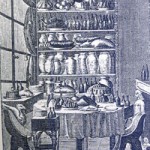Napoleonic Pleasures : 44
-
Bon appetit! / 2nd Republic / 2nd Empire, Directory / 1st EmpireChristmas Plum Pudding
-
Bon appetit! / Directory / 1st EmpireRacines purée
Root vegetables in the kitchen gardenAt the time of the First Empire the word “racines” (roots) was used to mean carrots, parsnips, salsify or black radish, in other words cultivated root vegetables, not the roots of wild plants that were gathered in times of famine. The carrot was very common, both at table and in animals' […]
-
Bon appetit! / Directory / 1st EmpireStock cubes (the fundamental ingredient for making a soup), used by soldiers
Soldiers' stewThese are the ancestors of the stock cube, used as a base for soups or to add flavour to rice and pasta. Feeding armies was a difficult business, and these tablets, which were easy to transport and did not go off, represented a quick meal solution, so long as the soldiers had water and […]
-
Bon appetit! / Directory / 1st EmpireWaffles "à la flamande"
In the street: waffles, Madeleines, and 'Echaudés'Many people lived in cramped apartments (which were particularly unbearable in summer) and often preferred to spend a good deal of time outdoors, either in the street or the courtyard. And as for snacks, there was no shortage of little shops or wandering salesman.
-
 Bon appetit! / Directory / 1st EmpireAubergines Masséna
Bon appetit! / Directory / 1st EmpireAubergines MassénaThe vegetable marketThis is a recipe for a vegetable terrine to accompany white or red meat. Garden vegetables featured prominently at banquets as part of the starter (hors d'oeuvres) and side dishes (entremets) courses. The king of the crop was the green bean, followed by asparagus, carrots, peas and turnips. In the early 19th century, […]
-
Bon appetit! / 2nd Republic / 2nd EmpireEggs (two recipes)
Eggs are good for youSecond only to meat when it comes to culinary diversity are eggs. This excellent foodstuff full of nourishment holds benefits for the healthy and sick, rich and poor alike.Fresh eggs soothe soreness of the chest; old ones are liable to upset those of a choleric or nervous temperament. To find out […]
-
Bon appetit! / Directory / 1st Empire"Échaudés"
This is a light dough thrown into boiling water which is then cooked for a few minutes in the oven. Children are particularly fond of these little cakes. Nowadays, little triangular cakes, flavoured with anise, are still sold in pâtisseries in the Auvergne region.
-
Bon appetit! / Directory / 1st EmpireRice pudding
Rice, are you done?In the 19th century, in classic French cuisine, rice was used in savoury dishes simply as a supplementary ingredient, useful as a base for soups; its use was primarily in sweet dishes along with eggs. On the other hand, rice as a basic foodstuff, accompanying a sauce, was a reality for most […]
-
Bon appetit! / Directory / 1st EmpirePudding
AnglomaniaEngland was certainly the enemy of old, but it remained oh so attractive. High society envied the gentleness of English manners, the good cut of English clothes, the speed and comfort of English cabriolets, and was fascinated by English gothic novels peopled by ghosts and ruined towers. When it came to cooking, the level of […]
-
Bon appetit! / Directory / 1st EmpireLeg of Hare "au soleil"
Leg of hare was a dish frequently served at First Empire tables, during dinners which lasted the entire afternoon. In cities, dinner could equally well be at 2 pm as at 6 pm. The Revolution turned the mealtime routine upside down. Breakfast was eaten between 8 and 9 am, most often taking the form of a […]

